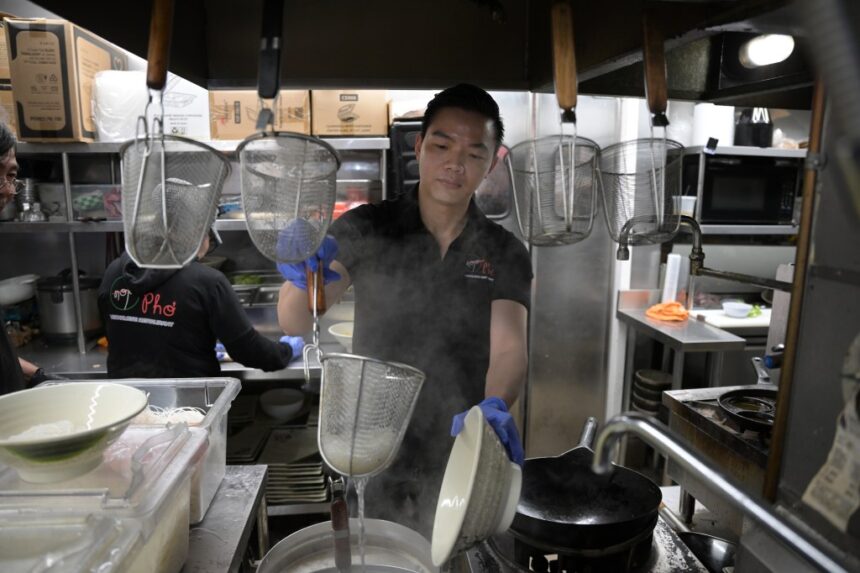Toan Le needs to drive his truck only a short distance from his home to his restaurant in Denver’s Little Saigon enclave. But in the minutes it takes to reach the business he opened in 2017, Le navigates potholes and narrow lanes on South Federal Boulevard.
“The infrastructure in Little Saigon is really not in good condition,” said Le, who grew up in the area and owns Now Phở. “It’s slowly deteriorating.”
He is among residents and business owners pushing government officials to invest in the Asian and Latino area — heavily made up of people of Vietnamese descent — on the city’s west side. Little Saigon largely extends down Federal, from Alameda Avenue to Mississippi Avenue.
In a stretch of town known for its pho joints and other Vietnamese eateries, locals are calling for resources to fix dilapidated streets, change burned-out lights and clean up graffiti. They argue that structural upgrades and better upkeep would not only spur tourism in the area, but also would make the neighborhood feel safer for community members.
Many in Little Saigon have felt overlooked. The city and state have plans to address some of the issues raised by residents and business owners through long-term projects in coming years, including the repaving of Federal and other neighborhood improvements. But for some, that work is still too far off, and more is needed.
At the nonprofit Colorado Asian Pacific United, executive director Joie Ha says she fields concerns about aging infrastructure and safety risks in Little Saigon, along with its growing lack of affordability.
The neighborhood is “becoming older, and it’s difficult to sustain. And a lot of businesses are actually moving out,” she said. “There is a real fear that the area will not be the same in the future.”
Earlier this year, Le’s restaurant was robbed around the time of the Lunar New Year celebration in February. At 3 a.m., thieves smashed the door and stole thousands of dollars in cash. Twenty-one days later, his restaurant was burglarized again.
“Owners like us don’t even feel safe to operate in our own space,” said Le, 30, who’d like to see more of a police presence.
One day, Le hopes Federal receives the same consideration from local and state officials as Colfax Avenue and the Broadway corridor. He can envision its potential.
“When you think about Federal Boulevard, you think about good food,” he said. “But, then, the condition of the street, the infrastructure, the exterior facade (of buildings) is not appealing enough to attract tourists.”

The neglect is disappointing, Le said, particularly since nearly 34,000 Coloradans identify as Vietnamese — the fifth-largest Asian-American, Native Hawaiian or Pacific Islander population statewide, according to the Colorado Lotus Project.
Future construction on Federal Boulevard
Such complaints aren’t new to Denver City Councilwoman Jamie Torres, who also hears laments from the fire department about potholes and cracks along Federal.
But she describes that street as “really complicated … because it’s also a state highway.” That means full-scale repaving falls under the jurisdiction of the Colorado Department of Transportation, not the city.
CDOT spokesperson Tamara Rollison said a repaving project is planned in the next two to four years.

The department also plans to make signal and safety improvements along Federal, and it’s in the study phase with the city of a potential bus rapid transit project along a much longer stretch of the corridor for later this decade, she said.
Meanwhile, Denver’s Department of Transportation and Infrastructure, or DOTI, plans to begin construction this summer through next summer on a $10 million green infrastructure project on South Federal, spokesperson Nancy Kuhn said.
It will include the installation of streetside tree lawns, and DOTI will also fix missing sidewalk segments and move some utility infrastructure underground. In some sections of Federal, it will reconstruct signals, build a center median and repave.
Separately, the city will put more than $50 million toward transportation in the neighborhoods on both sides of Federal, from Alameda south to Mississippi and from Sheridan Boulevard east to South Platte River Drive, with the contracting process set to begin this year, Kuhn says.
Those plans include bike lane installations, upgrades to the South Platte River Trail, and street safety and intersection improvements, according to a spreadsheet shared by DOTI.

A business improvement district?
Short of relying on the city for big upgrades, entrepreneurs like Le have highlighted a potential solution that could focus on smaller improvements: forming an official Little Saigon district, whether it’s a local maintenance district, a cultural district or a business improvement district.
But to establish the latter, which is common in commercial corridors across the city, would require a vote by commercial property owners. Those owners would then kick in money for the district’s activities by taxing themselves.
Le, who has owned his building since March 2020, wants to solicit opinions from his neighbors.
“I’m willing to be knocking on doors,” he said. “I’m willing to put in the money.”
Torres, the councilwoman, can see the value of turning Little Saigon into an official district, which could then take responsibility for area maintenance.

To the north, the Federal Boulevard Business Improvement District, or BID, was organized in 2012 in the Jefferson Park neighborhood and started collecting its mill levy on commercial properties in 2014. In 2022, it was set to raise an estimated $116,000 to invest in the area.
In Little Saigon, “we’d like to make the district a real district, but only if it makes sense and is desired by the businesses that are along that corridor,” Torres said.
While previous efforts to create a BID fizzled during the COVID-19 pandemic, Torres has recently reached out to business owners and held two meetings.
These conversations “should be rejuvenated once again, so that all of the businesses collectively would benefit,” said advocate Nga Vương-Sandoval, who was raised near Little Saigon after her family fled Vietnam. Her priority in the process is “ensuring that funding is allocated evenly and fairly,” she said, with decision-makers viewing it as a community investment, instead of a fiscal hindrance.

“It’s exhausting being in that area”
Without a BID, problems like graffiti removal and sidewalk repair don’t get handled as easily in Little Saigon. There are some lifelines for small businesses, such as limited city facade grants and programs through nonprofits like the West Denver Renaissance Collaborative within the Denver Housing Authority.
Still, small business owners often feel like they’re fending for themselves.
“There’s really no help and no funding to entrepreneurs,” said Linh Ton, owner of Vita Cane Sugarcane Juicery & Açaí Bar.
Ton opened her juice shop with her husband last July. She says she wants to operate in the area because of their heritage, with sugarcane juice a popular drink throughout Asia.
But since they opened, they’ve dealt with graffiti on a monthly basis. Ton watches their security camera at night as trespassers dig through their trash and defecate on the property.

“My husband does not want me working there alone at night,” she said.
Ton just met with the Denver Police Department about a break-in last month. While DPD says it does send extra patrols to the area when available, she would like to see more streetlights and more patrols around closing time, she said, because trouble happens when the sun goes down.
When the couple arrives in the morning to shattered windows, the damage often doesn’t meet their insurance deductible, so she says they can’t file claims.
“As a small business owner who’s been open for less than a year, we’re still playing catch-up on our construction costs,” Ton said. “We love our business and the brand, so we have so much faith in it. But it’s exhausting being in that area.”
Get more Colorado news by signing up for our daily Your Morning Dozen email newsletter.











